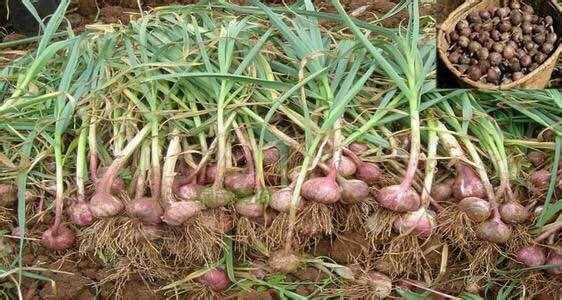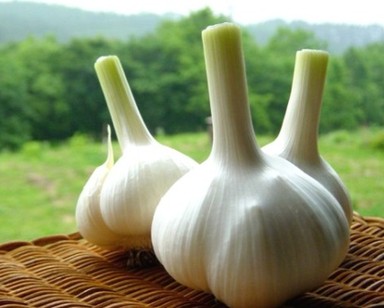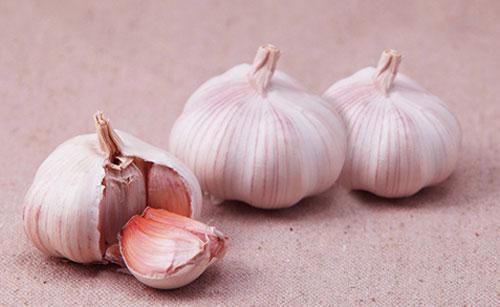Garlic profile
Written by Maggie
Feb 06 2021

Garlic picture

Morphological characteristics of garlic
Garlic root: Shallow-rooted crop without taproot. The root part of the hair is around the short stem, the lateral part is most, the medial part is less. The longest root of Garlic can reach more than 50cm, but the main root group is distributed in the soil layer of 5-25cm, and the cross-spreading range is 30cm. The number of hair roots of adult Garlic is 70-110.
Garlic stem: Bulbs are large, with 6-10 petals, covered with grayish white or lavender on membranous scales. Leaves of Garlic are basal, solid, flat, linear-lanceolate, ca. 2.5 cm wide, base sheathlike. Flower stem 9s erect, ca. 60 cm tall.
Garlic leaves: including body and sheath. The leaf sheaths are tubular, and the foliage is folded before exhibition, and flat and narrow after exhibition, with parallel veins. Leaves of Garlic are alternate, for 1/2 leaf inflorescence, symmetrical arrangement. The leaf sheaths interweave to form a pseudostem, which has the function of support and nutrient transport.
Garlic flowers and seeds: spathe with a long beak, 7 -- 10 cm long umbels, small and dense, with 1 -- 3 bracts, 8 -- 10 cm long, membranous, pale green flowers small, interflora with many reddish buds, 4 mm long, or no buds at all; Flower stalk of Garlic is thin, longer than flower; Garlic has 6 perianth, pink, elliptic-lanceolate;Stamens 6, white, anthers prominent; Garlic has 1 pistil, style prominent, white, ovary superior, long elliptic ovate, apex concave, 3-loculed.Capsule, 1-locular dehiscent. Seeds are black. Flowering period of Garlic is in summer.
Garlic growing method Temperature: Garlic likes cold and cool, the appropriate temperature is -5-26 °C. Garlic seedlings 4-5 leaf period of the strongest cold resistance, when the most suitable for overwintering seedlings. Light: Garlic flower bud and scale bud differentiation in the long sunshine and high temperature conditions for more than 13 hours, in the short sunshine and cold environment, only suitable for stem and leaf growth. 3. Moisture: Garlic likes moisture and afraid of drought
Soil and nutrition: the soil requirements are not strict, but rich in organic matter, loose and breathable, water retention and drainage performance of the fertile loam is more suitable.

The origin of Garlic
Garlic, native to western and central Asia, has been used for more than 2,000 years since Zhang Qian, a Chinese envoy in the Han Dynasty, brought the species home. Garlic is an indispensable condiment in human daily life.
Garlic nutritional value
Garlic is very rich in nutrients, and also has a very good therapeutic and medicinal value. Garlic bulbs are rich in protein, oligosaccharides and polysaccharides, as well as fats, minerals and so on. Garlic contains 4.4g protein, 0.2g fat, 23g carbohydrates, 0.7g crude fiber and 1.3g ash. Garlic is also rich in sulfur compounds, in which Garlic has bactericidal, bacteriostasis, anti-cancer, anti-aging and other health care functions. Garlic's precursor is allicin. Garlic acid exists in a stable and odorless form, and is catalyzed by allicinase to form a colorless oil called garicin. Garlic has attracted increasing attention in recent years. Garlic products have also become one of the most highly regarded health foods in the world. Since Pasteur proposed that Garlic has certain antibacterial activity in the 19th century, many scholars have become interested in the research in this field. Garlic is also known as "plant natural broad-spectrum antibiotic" because of its strong bactericidal force and wide antibacterial spectrum. In recent years, Chinese and foreign scholars have studied Garlic in many fields such as medicine and animal husbandry.

Latest Updated
- Benefits of Bugleweed - 7 Science-backed Health Benefits
- Bugleweed Dangers & Side Effects - Is It Poisonous?
- How to Plant Evergreen Trees - What You Should Know
- When to Plant Evergreens - Grow Guide for Evergreen Trees
- 12 Wonderful Evergreen Shrubs for Your Garden
- 12 Popular Evergreen Plants with Pictures for Beginners
- When And How To Prune A Lilac Bush Like a Pro
- How to Grow & Care for Lilac Vine (Hardenbergia Violacea)
- Japanese Lilac Tree (Syringa Reticulata) Care & Propagation Guide
- Shumard Oak Pros and Cons - What to Know
Popular Articles
- Winter maintenance of Antirrhinum Majus
- How to Grow Terminalia Mantaly Tree
- How to Grow and Care for Crossostephium Chinense
- How to grow Antirrhinum Majus in spring
- Peristeria Elata (Dove Orchid) Profile: Info & Care Guide
- Underwatered Snake Plant (Sansevieria Trifasciata) - Signs And How To Fix
- How to Care for Brazilian Jasmine Plant (Mandevilla Sanderi)
- How to Grow & Care for Graptopetalum Purple Delight in Summer
- Rosa Chinensis (China Rose): Plant Growing & Care Tips
- How to Care for Baby Sun Rose (Aptenia Cordifolia)